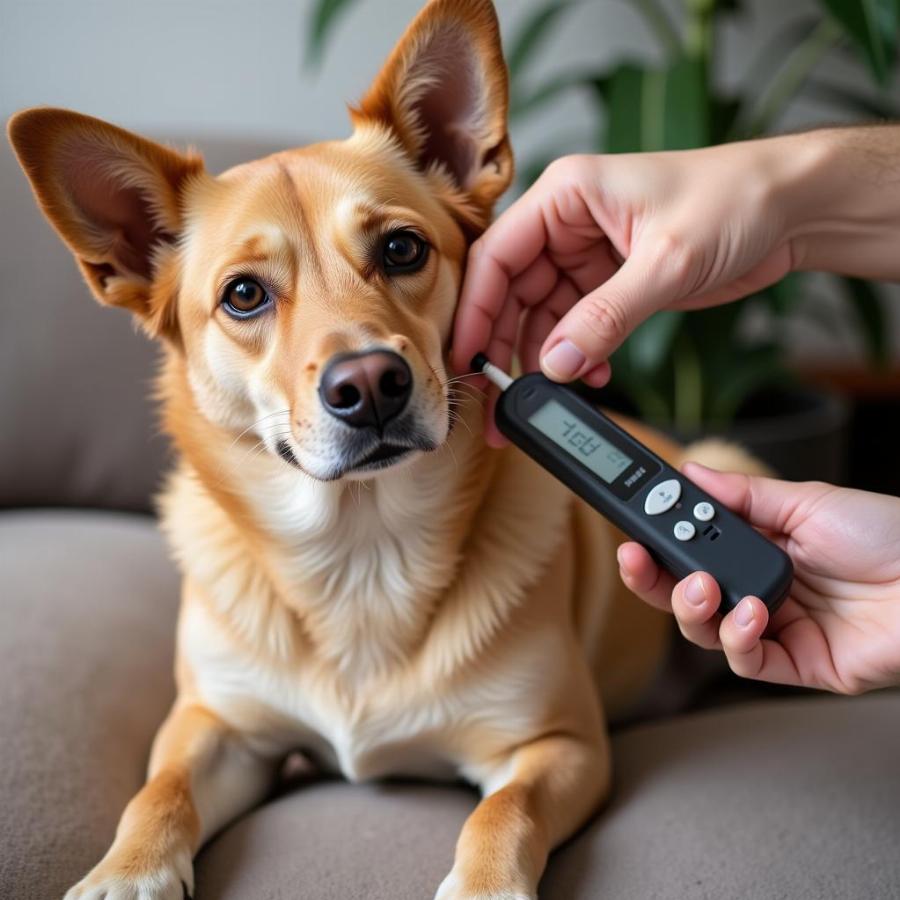A diabetic dog refusing food can be a serious concern for any pet owner. Diabetes itself can suppress appetite, but loss of interest in food can also signal other underlying health issues that need immediate veterinary attention. This article will guide you through the potential reasons why your diabetic dog might not be eating and offer practical solutions to stimulate their appetite and ensure they receive the necessary nutrition.
Why is My Diabetic Dog Not Eating?
Several factors can contribute to appetite loss in diabetic dogs. Understanding these causes is crucial for effective management.
Blood Sugar Fluctuations
Unstable blood sugar levels are a common culprit. Both high (hyperglycemia) and low (hypoglycemia) blood sugar can lead to nausea and decreased appetite. Consistent monitoring and insulin administration are essential to maintaining stable blood sugar and encouraging healthy eating habits.
Other Health Problems
Sometimes, the refusal to eat isn’t directly related to diabetes. Infections, kidney disease, pancreatitis, and even dental problems can cause discomfort and suppress appetite. It’s important to rule out these possibilities with your veterinarian.
Medication Side Effects
While insulin is crucial for managing diabetes, it can sometimes cause nausea as a side effect, especially if the dosage is incorrect. Discuss any potential side effects with your vet, who may adjust the insulin type or dosage.
Stress and Anxiety
Changes in routine, new environments, or even the presence of new pets in the household can stress a diabetic dog, leading to a temporary loss of appetite. Creating a calm and predictable environment can help alleviate this.
 Checking Blood Sugar of Diabetic Dog
Checking Blood Sugar of Diabetic Dog
How to Encourage Your Diabetic Dog to Eat
If your diabetic dog is refusing food, there are several strategies you can try to stimulate their appetite:
Offer Smaller, More Frequent Meals
Instead of two large meals, try offering smaller portions throughout the day. This can be less overwhelming for a dog with a reduced appetite and can help stabilize blood sugar levels.
Make Food More Appealing
Sometimes, a simple change in food presentation can make all the difference. Try warming the food slightly, adding a small amount of low-sodium chicken broth or mixing in a teaspoon of plain, unsweetened yogurt.
Hand-Feeding
Hand-feeding can create a positive association with food and encourage your dog to eat, especially if they are feeling anxious or unwell.
Try Different Foods
If your dog is consistently refusing their regular food, consider switching to a different brand or flavor, or even a different type of food altogether. Consult your vet about appropriate dietary changes for a diabetic dog. For information on selecting the right food for your diabetic dog, check out our article on choosing diabetic dog food.
When to Seek Veterinary Attention
If your diabetic dog’s appetite loss persists for more than 24 hours, or if they exhibit other symptoms like vomiting, lethargy, or excessive thirst, consult your veterinarian immediately. These could be signs of a more serious underlying condition.
What if my diabetic dog suddenly stops eating?
Sudden loss of appetite in a diabetic dog can be a sign of a serious medical issue, including hypoglycemia or diabetic ketoacidosis (DKA). Seek immediate veterinary care.
How can I tell if my diabetic dog is experiencing low blood sugar?
Signs of low blood sugar (hypoglycemia) include weakness, lethargy, trembling, seizures, and collapse. If you suspect hypoglycemia, rub a small amount of honey or corn syrup on your dog’s gums and contact your vet immediately. You can learn more about managing low blood sugar in dogs in this helpful article.
Can I give my diabetic dog human food to entice them to eat?
While it might be tempting to offer table scraps, many human foods are toxic to dogs and can worsen their diabetic condition. Stick to veterinarian-approved diabetic dog food and treats. Check our guide on safe treats for diabetic dogs for more information.
Conclusion
A diabetic dog refusing food can be a worrying situation. By understanding the potential causes, employing practical strategies to stimulate their appetite, and seeking timely veterinary attention when necessary, you can help your diabetic companion maintain a healthy and happy life.
FAQ
-
What are the signs of diabetes in dogs?
Increased thirst, increased urination, increased appetite (early stages), weight loss, lethargy, cataracts. -
How is canine diabetes diagnosed?
Through blood and urine tests. -
Is canine diabetes curable?
No, but it can be managed effectively with insulin therapy and dietary changes. -
How long can a diabetic dog live?
With proper management, a diabetic dog can live a relatively normal lifespan. -
What should I feed my diabetic dog?
A diet high in fiber and complex carbohydrates, low in fat and simple sugars. Consult your veterinarian for specific recommendations. -
What are some common complications of diabetes in dogs?
Cataracts, urinary tract infections, ketoacidosis, and hypoglycemia. -
Can stress affect a diabetic dog’s blood sugar levels?
Yes, stress can cause blood sugar levels to fluctuate.
For more helpful tips on caring for your diabetic dog, check out our other articles on managing diabetes in dogs and understanding canine insulin.
Beaut Dogs is your trusted source for comprehensive and reliable information on the world of dog breeds. We are dedicated to providing expert guidance on every aspect of dog ownership, from choosing the right breed to ensuring their well-being. When you need expert advice, contact us at Email: [email protected] for detailed and accurate answers.